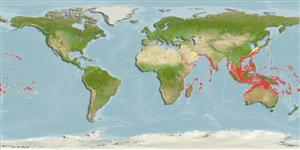Environment: milieu / climate zone / depth range / distribution range
पारिस्थितिकी
समुद्री प्रवाल-भित्ति संयुक्त; गहराई सीमा 0 - 180 m (Ref. 9710). Tropical; 35°N - 31°S, 33°E - 134°W (Ref. 55)
Indo-Pacific: East Africa to the Hawaiian Islands, north to southern Japan, south to Australia.
Length at first maturity / आकार / वज़न / Age
Maturity: Lm 45.0, range 42 - 50 cm
Max length : 112 cm TL पुल्लिंग / अलिंग; (Ref. 7196); common length : 90.0 cm TL पुल्लिंग / अलिंग; (Ref. 5450); अधिकतम प्रकाशित वज़न: 15.4 kg (Ref. 40637); अधिकतम सूचित उम्र: 32 वर्षो (Ref. 125573)
पृष्ठीय रीढ़ (सम्पूर्ण) : 10; पृष्ठीय सौफट रेज़ (सम्पूर्ण) : 11; गुदा कांटा: 3; ऐनल सौफट रेज़: 8. This species is distinguished by the following characters: body elongate and robust; very distinct horizontal groove on snout ventral to nostrils; teeth in both jaws in bands, with strong canines anteriorly; teeth on roof of mouth in chevron- or crescent-shaped patch on vomer and in elongate band on each palatine; maxilla without scales or longitudinal ridges; interorbital region flattened; gill rakers on first gill arch 7-8 + 13-16 = 20-24; preopercular edge smooth, sometimes denticulated in juveniles; last soft ray of both dorsal and anal fins well produced, longer than next to last ray; caudal fin forked; short pectoral fins, less than 1/2 length of head, about equal to length of snout; D X,11 soft rays; membranes of dorsal and anal fins without scales; tubed lateral-line scales 48-50. Colour of body dark green, bluish, or grey-blue (Ref. 55, 9821).
Adults inhabit open waters of deep lagoons, channels, or seaward reefs (Ref. 9710). Found in benthopelagic waters (Ref. 58302). Usually seen singly, but also in groups. They feed mainly on fishes, but also on shrimps, crabs, cephalopods and planktonic organisms (Ref. 30573, 48635). Mainly marketed fresh but also dried and salted. Excellent eating. Large individuals may be ciguatoxic (Ref. 37816).
Allen, G.R., 1985. FAO Species Catalogue. Vol. 6. Snappers of the world. An annotated and illustrated catalogue of lutjanid species known to date. FAO Fish. Synop. 125(6):208 p. Rome: FAO. (Ref. 55)
IUCN Red List Status (Ref. 130435: Version 2024-1)
Threat to humans
Reports of ciguatera poisoning (Ref. 4690)
Human uses
मात्स्यिकी: उच्च वाणिज्य; आखेट मत्स्य: हां; जलजीवालय: व्यापारिक
साधन
Special reports
Download XML
इंटरनेट स्रोत
Estimates based on models
Preferred temperature (Ref.
123201): 23.9 - 29, mean 27.9 °C (based on 2222 cells).
Phylogenetic diversity index (Ref.
82804): PD
50 = 1.0000 [Uniqueness, from 0.5 = low to 2.0 = high].
Bayesian length-weight: a=0.01413 (0.01192 - 0.01674), b=2.94 (2.89 - 2.99), in cm total length, based on LWR estimates for this species (Ref.
93245).
Trophic level (Ref.
69278): 4.3 ±0.4 se; based on diet studies.
Generation time: 3.8 (3.3 - 7.8) years. Estimated as median ln(3)/K based on 12
growth studies.
लौटाव (Ref.
120179): माध्यम, न्यूनतम जनसंख्या दुगनी होने का समय 1.4 - 4.4 वर्ष। (K=0.29; tm=4-5).
Prior r = 0.28, 95% CL = 0.18 - 0.42, Based on 1 full stock assessment.
Fishing Vulnerability (Ref.
59153): Moderate vulnerability (40 of 100).
Nutrients (Ref.
124155): Calcium = 19.1 [9.1, 35.8] mg/100g; Iron = 0.514 [0.226, 0.991] mg/100g; Protein = 19.1 [17.2, 20.8] %; Omega3 = 0.153 [0.091, 0.252] g/100g; Selenium = 40.7 [20.9, 75.2] μg/100g; VitaminA = 87.7 [31.2, 272.9] μg/100g; Zinc = 1.56 [0.42, 2.27] mg/100g (wet weight); based on
nutrient studies.
